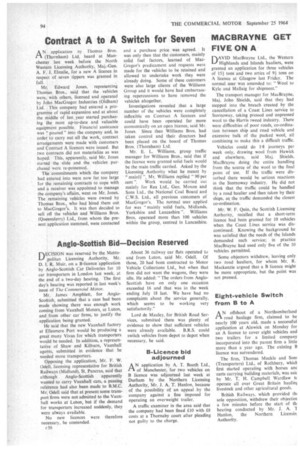FIVE ON A
Page 98

If you've noticed an error in this article please click here to report it so we can fix it.
nAVID MacBrayne Ltd., the Western
Highlands and Islands hauliers, were granted an application for three vehicles of 154 tons and two artics of 91 tons on A licence at Glasgow last Friday. The normal user was amended to: "Wool to Kyle and Mallaig for shipment."
The transport manager for MacBrayne. Maj. John Shields, said that they had stepped into the breach created by the cancellation of a Coast Lines service to Stornoway, taking pressed and unpressed wool to the ,Harris tweed industry. There were difficulties of poor roads, co-ordination between ship and road vehicle and excessive bulk of the packed wool, all combining to make this a difficult traffic.
Vehicles could do 1.8 journeys per week only, drawing wool from Hawick and elsewhere, said Maj. Shields. MacBrayne doing the entire handling from the source of the wool to the final point of use. If the traffic were disturbed there would be serious reactions in the Stornoway industry. He did not think that the traffic could be handled by a road haulier and then taken by their ships, as. the traffic demanded the closest co-ordination.
Mr. W. F. Quin, the Scottish Licensing' Authority, recalled that a short-term licence had been granted for 10 vehicles when the Coast Lines service was discontinued. Knowing the background he was satisfied that the needs of the Islands demanded such service; in practice MacBrayne had used only five of the 10 vehicles permitted.
Some objectors withdrew, leaving only two road hauliers, for whom Mr. R. Mackenzie argued that a B licence might be more appropriate, but the point was not pressed.






































































































































































































































































































































































































